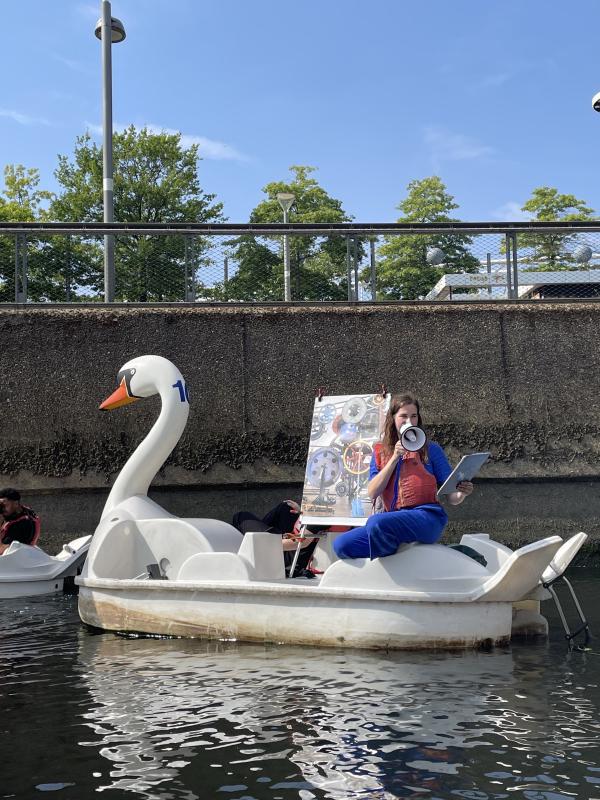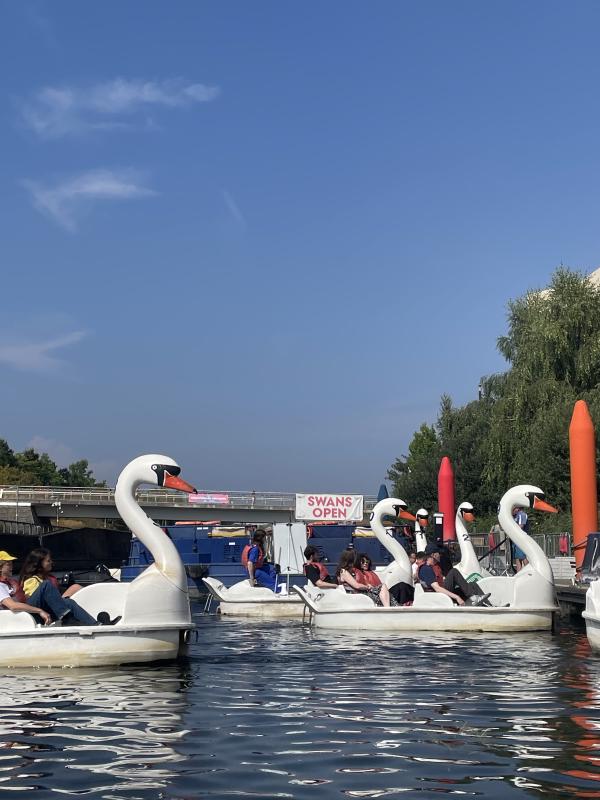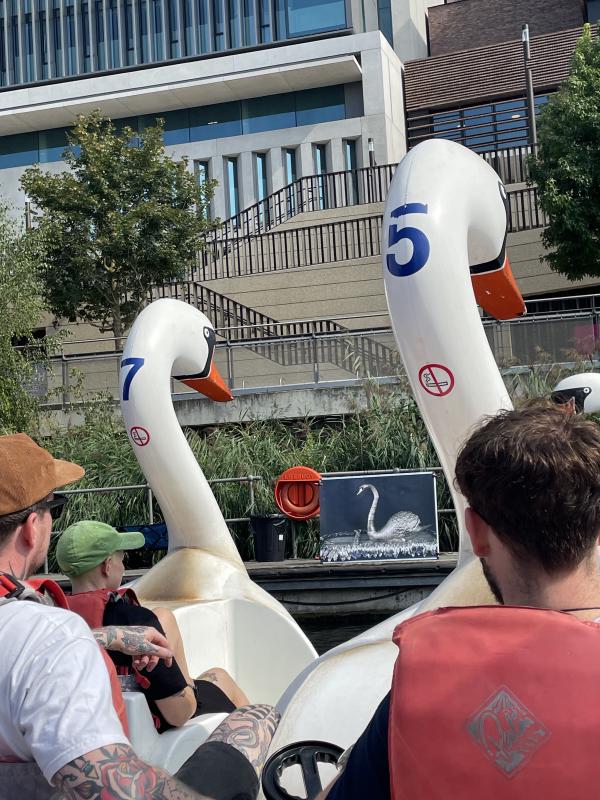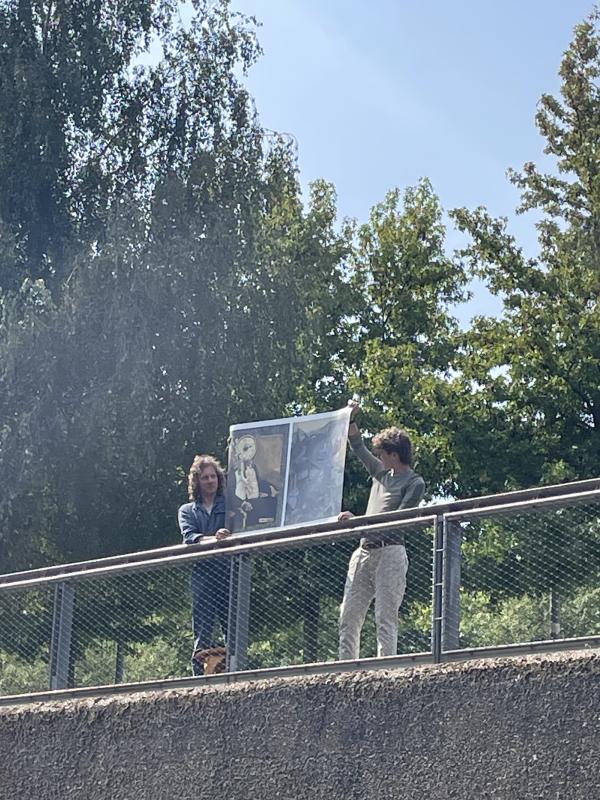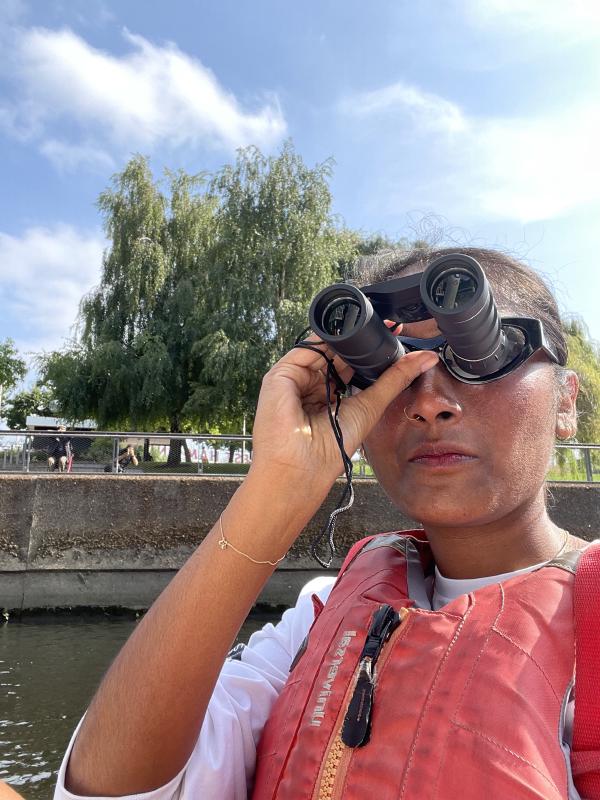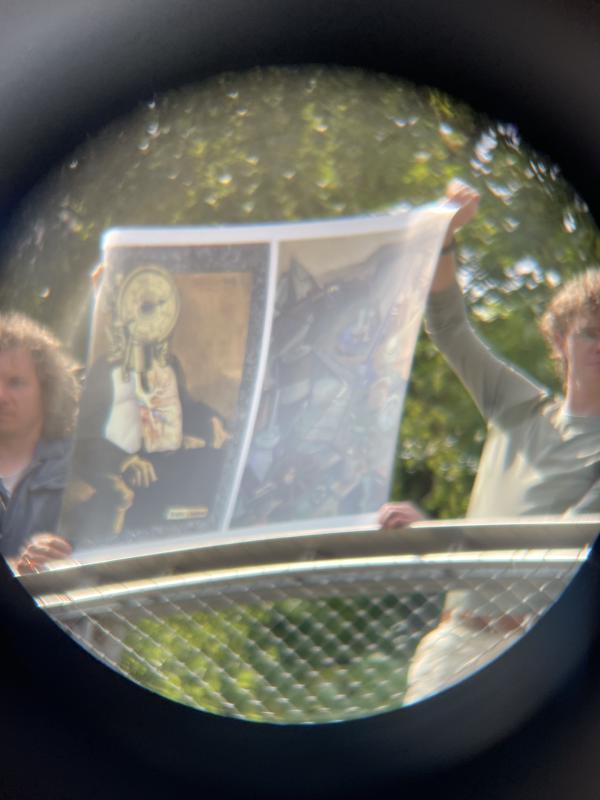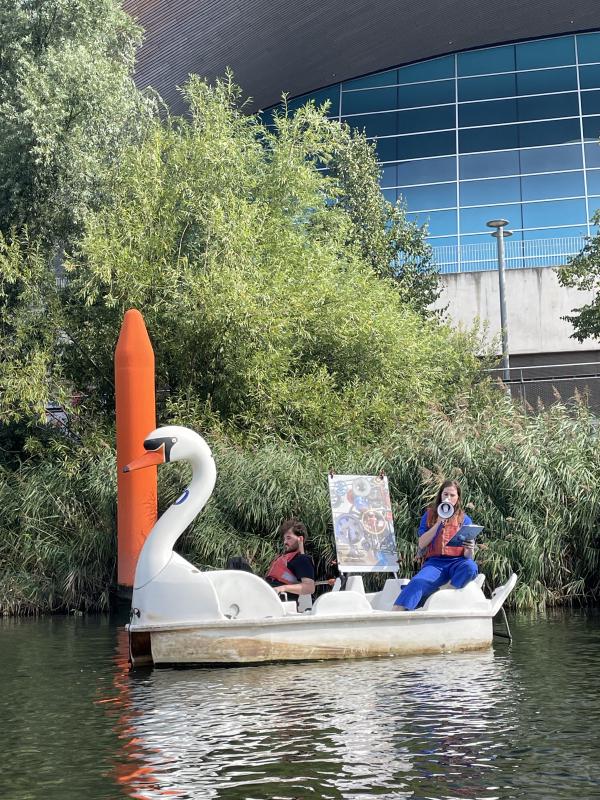Dream Machines, by Rebecca Moss
ZM
Peak August. A very sunny Sunday morning. I scraped myself together early and got the bus to Stratford. It’s a weird part of the city, isn’t it? The shopping centre and the football stadium make it feel like a toy town. The ArcelorMittal Orbit is a sculpture, a slide, a tower and a massive advert for a multinational steel corporation. Capital projects to regenerate former industrial zones, relocating cultural institutions out East in the former Olympicopolis. Nestled in between the enormous newbuild offices, the new Sadler’s Wells, BBC and UAL buildings with their glassy walls and glossy concrete facades — there’s the river Lea. The Lea splinters over the Walthamstow Wetlands, trickles down over the Hackney Marshes and past Stratford on its way down to Bow where it meets the Thames. It is ancient, the Romans the Celts and the Anglo-Saxons sailed up and down it on their trade routes, the plague-dead were sailed up the Lea and out of London, Queen Mathilda slipped on her way to Barking Abbey and ordered a bow-shaped bridge be built — and that’s why Bow is called Bow. The river Lea, ancient and glassy, glossy hard. The towering newbuilds reflect off its surface, this weird part of the city. Almost liminal.
I joined a crowd of 40 strangers outside the tube station. We walked over the sun baked shopping centre tiles, towards the water. Standing on the jetty, a man handed me a lifejacket and a pair of binoculars in a fabric case. The scene gave me deja vu. Not a feeling or a sense that grew within me, I was given it. It hit me hard. I have dreamed this already, I thought, I am sure. I looked out at the water, looked out at the 10 swan pedaloes bobbing by the dock. I looked at the strangers clambering aboard them, in their lifejackets, with their binoculars in hand. I looked down at myself, at the binoculars slung around my neck. If I’d had a dream like this, surely I’d remember it? Surely it’d be vivid? This felt very vivid. A man wearing a polo shirt and petrol station sunglasses took my hand and helped me into a pedalo (swan no. 6). I somehow found myself in the drivers’ seat next to a man called Simon. Simon winked, saluted, said aye aye captain. We pushed off from the dock and pedalled round in a big loose circle, my hand clenched on the steering stick. A lamentation of swans, yes. Crowd of strangers dissolved into a we.
Rebecca Moss is an artist interested in absurdity and objects, I think. I’ve seen her work around before. A video called Home Improvement at a Jerwood group show. The artist sits in a garden in a grey dressing gown. She’s on a chair, on either side of her there’s a rig set up with buckets on a string, jacked up to a pulley with two coat hangers on the other end. Two watering cans attached to a plank that she can operate with her foot. In the chair, she puts the hanger hooks in her mouth and stamps down on the plank. The watering cans tip water into the buckets, the buckets fill with water and weight, tugging on the hangers on the other end. The buckets sag and sink, and the artist’s face holds the tension, contorting into a painful smile with tight cheeks. It’s almost dark, almost body horror. Her face looks unreal, pinched and uncomfortable. I’m clenched, because part of me is waiting for her cheeks to rip open. But it’s also too absurd to be truly tense, a kind of physical comedy. Another video, Thick-skinned. The artist is covered in multi-coloured party balloons. Her gait is wide as she waddles towards the camera, her arms stiff at angles because the balloons pad her entire body. She approaches a barbed wire fence. She hesitates. She bends, sticks an arm through, then her head, then another arm. The balloons pop around her. She sheds them like a layer as they burst, freeing a leg. I can’t watch it without wincing. Just like Home Improvement, it toes a careful line between physical comedy and body horror. Maybe they are twin-states, two sides of the same coin, inseparable. The artist pulls her last leg over, snagging balloon and maybe also flesh on the barbed wire. She crawls, pulling her body through, leaving a train of tattered balloons tangled in the fence.
Between those two things (absurdity and objects) there’s space for something else, I think it’s action, or interaction, movement, play. In the drivers’ seat on swan pedalo no. 6, splashing out lazy circles on the water, we parked up amongst the other swans. Rebecca Moss had a megaphone and a clipboard with a swan printed on the back. She was perched on the back of a pedalo with a flipboard propped up next to her. She was delivering a lecture called Dream Machines, about movement, machines, industrialisation, automation, Dada and Surrealism.
The first image on the flipboard was a close up photo of Jean Tinguely’s Fatamorgana – Méta-Harmonie IV. Jean Tinguely was a Swiss artist who made kinetic art. Whimsical, erratic sculptures — machines, automata, contraptions. He made scribbling machines, things that moved, span, crunched gears, made sounds. Many of his works used household items and bits of junk. He made a series of works called Métamatics, machines that produced artworks. One painted abstract paintings, at max speed it made 20,000 paintings a day. He made mechanical sculptures that self-desctructed in grand spectacles. This was slap bang in the middle of the 20th century. The machinised chaos is very Dada, very anti-art, something is being subverted or satirised. The mystical value that artistic labour supposedly manufactures, the supremacy of meaning, the art object’s pristine and serious aura, machines as perfect, capitalism as constant progress — something is being punctured — maybe it is the very idea of sense itself. Play is a vivid destabilising force. Jean Tinguely’s Fatamorgana – Méta-Harmonie IV is a machine that makes a clunky music that rips through the state you’re in. The gears turn and set each other off and they screech in wicked harmony.
We pedalled the swans over the water, to a new patch by the reeds. We thought about movement and the energy in movement. Someone unfurled another image, hidden at the back of their pedalo. Someone unfurled an image on the jetty. Two more people high up on the bank unfurled an image. We squinted at them through our binoculars and through the blaring sun. The silver mechanised swan at the Bowes Museum, a Victorian curiosity. Hannah Hoch’s watercolour, Mechanised Garden. Swan pedalos have an interesting history, tied up in the history of leisure and recreation, pleasure and public space. I might be imagining it, but are they Victorian? A combination of bicycle and boat? Something about the industrial revolution? Apparently there’s a park in Boston where swan boats have been operating since the 1800s, a ship-builder called Robert Paget had the idea when he went to see a Wagner opera. The finale builds and the hero rescues the damsel, crossing the river on a swan. What a satisfyingly neat circle: from art to invention, all the way back to art again. It makes the art sound like an inciting incident.
Automation and technology and pleasure and leisure and movement and beautiful objects and function. Sense, nonsense, absurdity, play, fun. Rebecca’s lecture ripped through a neat circle, or it added more points, building the circle out into a many-sided shape. Those things are all connected, all linked in tenuous and explicit ways. Industrialisation should’ve led to less work and more leisure — for everyone. Machines are not perfect and capitalism’s progress is not shared. In that way, capitalism is a kind of dreamstate. We turn to culture for respite, excess. I don’t know if it is a luxury or a fundamental human right. I guess it is both, enrichment. Play. It is also deadly serious. It is able to toe that line and be both at the same time. Dada and anti-art, when the form ate itself alive and disintegrated to be reborn. A destabilising force hits like a wave: undercuts the thing to get to the heart of it.
You need something vivid, something to shock the system. Capitalism or modernity, life as we know it, whatever you want to call it. It is such a neat circle, it seems irrefutable, like there is no alternative. Didn’t Mark Fisher say that? Capitalist Realism? I don’t know, it just seems so glossy and hard, a glass exterior, an impenetrable dreamstate. Rebecca Moss ripped through the circle, good clean fun. We just put our bodies in a different state, outside the lecture theatre and onto the water. Moving about on the water, pedalling along in swan no. 6 — the vivid shock doesn’t have to be aggressive or violent to puncture the dreamstate, it can be elegant too. We lined the swans up in a perfect row. Simon said, hey, I wonder what’s over there? pointing into the reeds along the furthest bank. I didn’t know, so we pedalled right into it.
